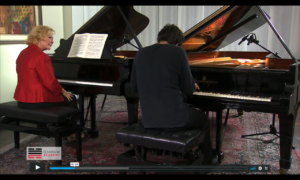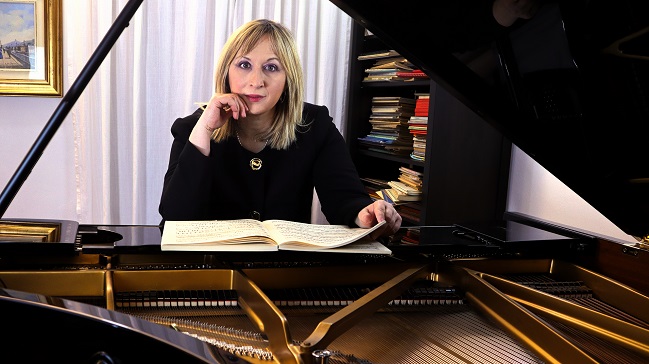BEETHOVEN SONATA NO. 23, OP.57, APPASSIONATA
CORNERSTONE LESSON BEETHOVEN
The composer himself described this composition Appassionata as one of the best he ever wrote, and it is no doubt the most celebrated of Beethoven’s piano sonatas; the 1st movement, reporting the tempo indication " Allegro assai" contains five thematic/rhythmical elements, exposed in detail by our teacher. Professor: Gulsin Onay. She then goes from the peaceful Andante con Moto of the 2nd movement to the Allegro of the 3rd movement, with its 'Perpetuum mobile,' which she very precisely examines.

Professor Gülsin Onay and assistant Gorkem Tokur
One of the most sensibility demanding fragments of this sonata, going from Pianissimo to Forte. Here's how to build the phrasing and the intensity.
History of the piece
Composed with long labor between the summer of 1804 and the first months of the following year, it still revised in the final draft of May 1806, when Beethoven was a guest of the Brunsviks at their Hungarian estate in Martonvàsar. The Sonata in F minor was published as op. 57 from the Bureau des Arts et d'Industrie of Vienna in February 1807, with the dedication to Count Franz von Brunsvik, brother of Therese and Josephine, with whom the musician was engaged in crossed love skirmishes (according to Therese's testimony, it was at that time that Beethoven secretly got engaged to Josephine). The title Appassionata, which did not appear in the first publication, appeared for the first time only after the death of Beethoven in a piano edition of 1838 at Cranz in Hamburg. Since then, it has always been maintained. We do not know if Beethoven had had time to endorse it or not. Still, circumstances lead us to doubt that it could refer to a contingent or utopian love passion for the "immortal beloved," and rather, a trace for highlighting that violent contrast of principles - the very essence of metaphysical passion - that distinguishes its character. The Appassionata is a peak of the passionate expression of her age but at the same time represents the overcoming of sentiment under its expansion and the splendor of form.
A particular phrase in which we find some aggressive accents, which have to be expressed as " coming from nowhere," as Professor Onay specifies.
What to expect in the Masterclass
The most important aims are to master a toolbox of methods about how to render passion and intensity. As many players already know, playing passages with great intensity means playing other passages with excellent softness and sensibility. A piece cannot be intense all along; we must understand how to perform so that the contrast between the different parts can be noticed and appreciated by our audience. As a consequence, the masterclass contains the treatment of the overall vision of this composition together with attention to small but crucial details and the achievement of crosspoints in the playing to switch from tender to intense, as well as from Pianissimo to Fortissimo.
Sometimes we instinctively decide to put accents, which could be right, but here the composer didn't write any accent, so how do we interpret the "Not Written Accents"?
Masterclass review
Gusin Onay has a great passion for intense and loud sounds and an unrivalled capability to play straight and Forte. Her technique is a precious example of this kind of composition. So in this masterclass, the main aspect of the teacher's style is her native talent and skill to get the best out of the instrument that she's playing, from the first on to the very last note, and the musical ideology that underlines the whole masterclass is undoubtedly something that cannot be missed in a pianist musical culture.


